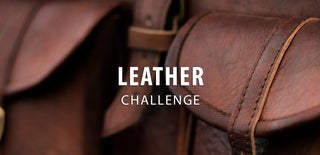Introduction: Adding Metallic Detailing to Leather Without a Hot Foil Machine
So if you're like me, you've been pottering around the edges of leatherwork for a few years now, and while you have *some* supplies and have sewn a few pieces for your daily use and as gifts, you're still disappointed when you compare the quality of your work with professionals. One technique which I've always been particularly jealous of is the technique of foil embossing leather work, as it ads personalisation or embellishments to otherwise simple projects to make them personal and, well, fancy.
Unfortunatley when looking into this I discovered that hot foil stamping is a process that require specialty equipment, which is an investment that I just can't justify for my own little projects. They traditionally require custom cut metal dies, and them a hot stamping machine of some kind. Even new crafting techniques like the Cricut (which removes the need for a separate die for each pattern you want to emboss) is still a significant investment.
Finally, in absence of a way to replicate this process exactly, I decided to turn to an older crafting technique, embossing powders. These have been used by crafters on cardstock for decades, and are essentially a powdered glitter that can be glued to a surface, then fused together with a heat gun. Knowing this, I decided to do an experiement to optimise embossign on leather, for the best outcome.
Supplies
To do the experiment (though not the final embossing) you'll need
-Some leather (scraps are fine, but you want the surface finish to be the same as what you'll be embossing for your finished project)
-Embossing Powder (I used Solid Gold from Crafters Choice)
- A heat gun
- Masking tape (optional)
-Adhesives. In this experiment we're using a Crafters Choice embossing pen, a glue pen, double sided tape, and an acid free spray adhesive.
Step 1: Step 1: Prepare Your Samples.
So because we're trying to be scientific here, we'll try and make sure all our tests are equivalent. To do this I cut my piece of pre-dyed leather (this is a kangaroo veg-tanned leather I've dyed with a black alcohol ink), into 6 pieces and labelled them with a paint pen to distiguish them. We're going to 5 different methods of making an adhesive pattern and embossing, and one control without adhesive (cause science).
The 5 methods I tested were:
1 - Drawing with the embossing pen
2 - Drawing with the glue pen
3 - Marking out the pattern with double sided tape
4 - Stenciling out the pattern with masking tape and spraying adhesive in the shape I wanted
5 - Masking the whole piece, and using the laser engraver at work to cut a stencil in the mask, then using the spray adhesive
6 - No adhesive, just embossing powder and heat.
In all these tests I used the letter "N" as my test pattern. I poured and heat melted the embossing powder as a set, rather than doing each one individually.
Step 2: Test 1: Embossing Pen
This was the easiest, I literally took the embossing pen and wrote an "N" on the leather. I did have to go over it a couple of times so it stood out though.
Step 3: Test 2: Glue Pen
This went pretty much the same as the embossing pen, except the glue (at least when it's wet) was a white colour, which contrasted better with the leather and made it easier to see where I'd already laid adhesive.
Step 4: Test 3: Double Sided Tape
So for this test I took strips of thin double sided tape, and laid them in the test pattern. This tape is designed to have a non-adhesive layer on the top, so when you peel it off the roll it's only adhesive on the bottom. Then, after you've got it in place, you peel the top layer off leaving a layer of double sided tape in the position you want. I forgot to take a photo of the "sticky only" part of the pattern, but you can see it in the group photos when I embossed later.
Step 5: Test 4a: Masking Out a Stencil
For this piece, I cut small pieces of masking tape out to make a stencil of the pattern I wanted to emboss. It ended up being several layers of tape overlapping, but since the masking tape peels off easily that's not really an issue.
Step 6: Test 5a: Lasercut Masking Tape Stencil
So for this piece I masked the whole piece of leather, then used the laser cutter at work on a low power to cut out a stencil. I then carefully peeled the stencil for spraying. If you don't have access to a laser cutter, this could probably be done with a pencil and a crafting knife just as easily, but I like the clean straight lines of a cnc devices that I can't get with my own hands, so...
Step 7: Test 4b and 5b: Spraying the Stencils
For this step I just laid the two masked out pieces on a scrap of paper and sprayed them with a crafting spray adhesive. This one is acid free and designed for sticking photos into scrapbooks, I believe, but it works well for this too. As always when using aersol chemicals, do so in a well ventilated area, and make sure you remove anything nearby you don't want to get any overspray on.
Step 8: Step 2: Spread Embossing Powder.
This step is alarmingly easy. Lay your adhesive prepared samples on a piece of office paper. Then take your embossing powder and sprinkle liberally across the samples. Be generous, cover your whole sample, you're going to be able to reclaim most of the embossing powder later.
Once you've covered your pieces, pour excess powder onto the office paper, and tap the piece to remove any excess. You can now (carefully) lift up the sheet of paper and (folding a small notch in one edge) use it as a funnel to return any remaining embossing powder to the container for next time.
Step 9: Step 3: Melting Your Embossing Powder With a Heat Gun
Now craft stores do sell custom heat guns for craft use. These use a lower temperature and lower fan speed than industrial heat guns. But, if you're careful, and only have access to the heat gun from your toolbox in the shed, that will definitely work too.
Setting the heat gun to it's lowest setting, and keeping the gun a fair distance (at least 30cm/1foot to start with) from the sample, pass the hot air across your pieces, moving the air stream back and forth across the surface while slowly moving towards your job. You may want to hold down your pieces if they are quite light, but be aware heat guns can be very dangerous (especially to your hands). You may want to use long tweezers or some weights.
Soon you will see the powder change colour and fuse into larger blobs keep going slowly and the adjacent blobs should melt together into the shape of the powder adhered to the surface.
Step 10: Step 4: Remove Any Masking and Compare Your Results
So after putting down your heat gun somewhere safe, I carefully peeled the masking tape off the samples I masked. I then checked my outcomes.
The first thing I noticed was that every sample that hadn't been masked (even the control 6) had random flecks of embossing powder that had fused to the leather outside my desired pattern. For me then, masking out the desired shape is a must.
When comparing the two masking tape designs, the stencil made by hand had fused better while the laser cut one had bubbled a bit. I put this down to me stuffing up the adhesive spraying though. I think I had a glob of the adhesive in one section from spraying too close to the sample, and not letting it dry properly before adding the embossing powder. My recommendation would be to use long distance, light sprays over the stencil, and make multiple coats, before adding your powder.
Step 11: Step 5: Use Your Newfound Knowledge to Make Nicer Looking Projects!
So immediately after the experiment I personalized this leather-bound book I had made for a friends birthday (he hasn't seen it yet, I hope he doesn't see this here before I give it to him).
Because of the intricacies of the pattern I was stenciling, I opted to use the laser cutter to cut out the stencil on the leather cover. I then used the spray adhesive and gold embossing powder, as in the test.
In conclusion I think it looks pretty good... from afar. Up close it's still blotchy and bubbly, more like poorly applied thick paint than smooth foil embossing. It also stands proud out of the leather, as compared to stamped in as you'd see with hot stamping. So I guess I'm still holding out for a cricut (or Silhouette...). one day.

Participated in the
Leather Challenge













